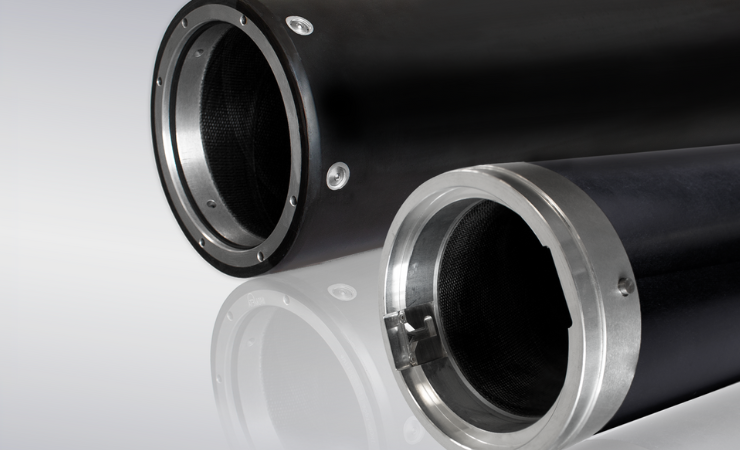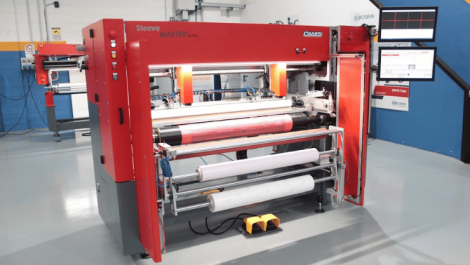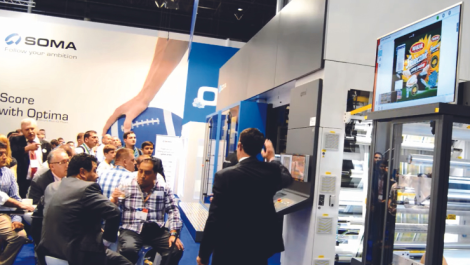The right adapter sleeve (also known as a bridge sleeve) can make a profound difference to on-press productivity and profitability, with these products now the focus of significant research and development resources.
Adapter sleeve technology has become an area of cutting-edge advancement, encompassing compressed air flow models, materials development and construction excellence. Manufacturers of today’s adapter sleeves – who generally also manufacture plate mounting sleeves too – will often point to the use of lighter weight materials, compressible layers, and robust end seals that are intended to give flexo printers reliable and effective ways of tackling the age[1]old problem of bounce.
There are more poetic ways of expressing ‘bounce’. Ellen Brimble, managing director at Rossini UK, explains that, ‘Everyone has seen the improvements in press design, innovation and stability in recent years, however there will always be plate design/topography that creates harmonic resonances and deck vibrations that adversely affect print quality and output.
Harmonic resonances and deck vibrations indeed. But whatever name you give it, bounce remains a real problem for flexo press operators to grapple with, and getting the right adapter sleeve can help them do so more effectively. In turn, this enables presses to run faster, produce jobs more quickly and contribute significantly to a print business’s bottom line. Ms Brimble says that companies using Rossini’s FastBridge adapter sleeves are achieving around 30% more output. The product itself is made from carbon fibre and was born out of the requirement to increase press speeds on demanding print jobs. It enables printing of the highest quality, up to 800m/min, the company claims.
‘One of our customers agreed to undertake comprehensive testing linked to comparative real world like for like data,’ Ms Brimble continued. ‘After a number of weeks running FastBridge in full production and the customer analysing the data, the results were astonishing, described by the print manager as a real game changing product. After a further two weeks of testing to confirm the data, the customer embarked on an upgrade process, making the switch to FastBridge on three of its presses over the next few months.’
Subsequently, she says, many other customers and OEMs, both large and small, have undertaken comparative trials, seeking to unlock their press capacity potential. ‘This has been extremely positive and successful. Even older presses have benefited massively, breathing new life into them by making them more productive, profitable and sustainable,’ said Ms Brimble.
Dispersing vibrations
The use of lightweight materials in the construction of the adapter is nowadays commonplace. Tech Sleeves, a sister company to AV Flexologic and part of the Color Control Group, has been prominent in this field, with its Tech Carbon + High Modulus Press Adapter offering, which takes into consideration weight combined with bounce mitigating properties. ‘All printing presses have some sort of vibrations and resonance which needs to be absorbed whether it be by the sleeve or adapter. Our adapters are constructed with a hollow core to dampen the vibrations whilst having a focus on weight saving opportunities.’ says Nick Vietnieks, general manager at Tech Sleeves.
‘Combining both the Tech Pro Light sleeve and Carbon + adapter, it guarantees one of the stiffest and lightest combination sleeve/adapters on the market, in a time where lightweight is surely a focus point.’
The carbon adapters are manufactured using ‘precision’ winding technology whilst using a premium grade carbon fibre and vinyl ester resin mix which, along with an outer metal ring, gives key characteristics to promote what Tech Sleeves says is the best sleeve adapter combination on the market.
For Dantex, the need to reduce the weight of adapter sleeves and make them as cost effective as possible means upholding the highest quality standards in production so that the sleeves perform reliably for longer.
‘Dantex adapters have several technical advantages that make them superior to others on the market,’ says Kuba Kostro of the company. These features include the even distribution of air across the sleeve, making it easier for the operator to mount and dismount the sleeve, a full aluminium ring at the front of the adapter and a solid interlock ring with aluminium structural ring at the other end, the sealing of the inner core to ring connection to prevent cleaning solution from getting inside the adapter, and conductivity across the adapter’s surface, making it a very safe solution.
Distributing air
The focus of XSYS’s most recent innovation in this field has been around the distribution of compressed air, which is critical both in mounting and demounting adapter sleeves, and in them fitting perfectly to the mandrel inside the press. XSYS sells the rotec range of sleeves and adapters, and these now make use of its patented Eco Bridge technology, developed, says XSYS, to improve sleeve mounting efficiency and long[1]term sustainability.
It uses a ‘unique’ air distribution system incorporating a breathable metal ring (optionally the company’s new and more robust Eco Xtra Ring) at the operator end of the adapter. This makes mounting much easier as the operator can ‘float’ the sleeve into place. Eco Bridge also requires up to 90% less compressed air compared to standard adapters, according to XSYS, especially helpful for printers with inconsistent or overburdened compressed air systems. Quicker mounting equates to quicker job changes.
‘We have experienced first-hand how mounting issues or air supply problems can compromise a whole print business,’ says Silvia Kabus, rotec sales director at XSYS. ‘One customer was forced to stop using the top print decks of their CI press simply because mounting had become too difficult and dangerous for the operators. Another was unable to take advantage of using adapters in the press because their compressed air system was not sufficient. Eco Bridge technology provided the solution to fix these problems.’
It is important to consult with your sleeve manufacturer to ensure your adapters are configured to the type of press and application being produced, and XSYS has brought this service to the online sphere now, with the introduction of its rotec Adapter Configuration Tool, offering product guidance and enabling flexo converters to create adapters based on dimensions, application specifics, preferred air source, air distribution and any relevant upgrades.






